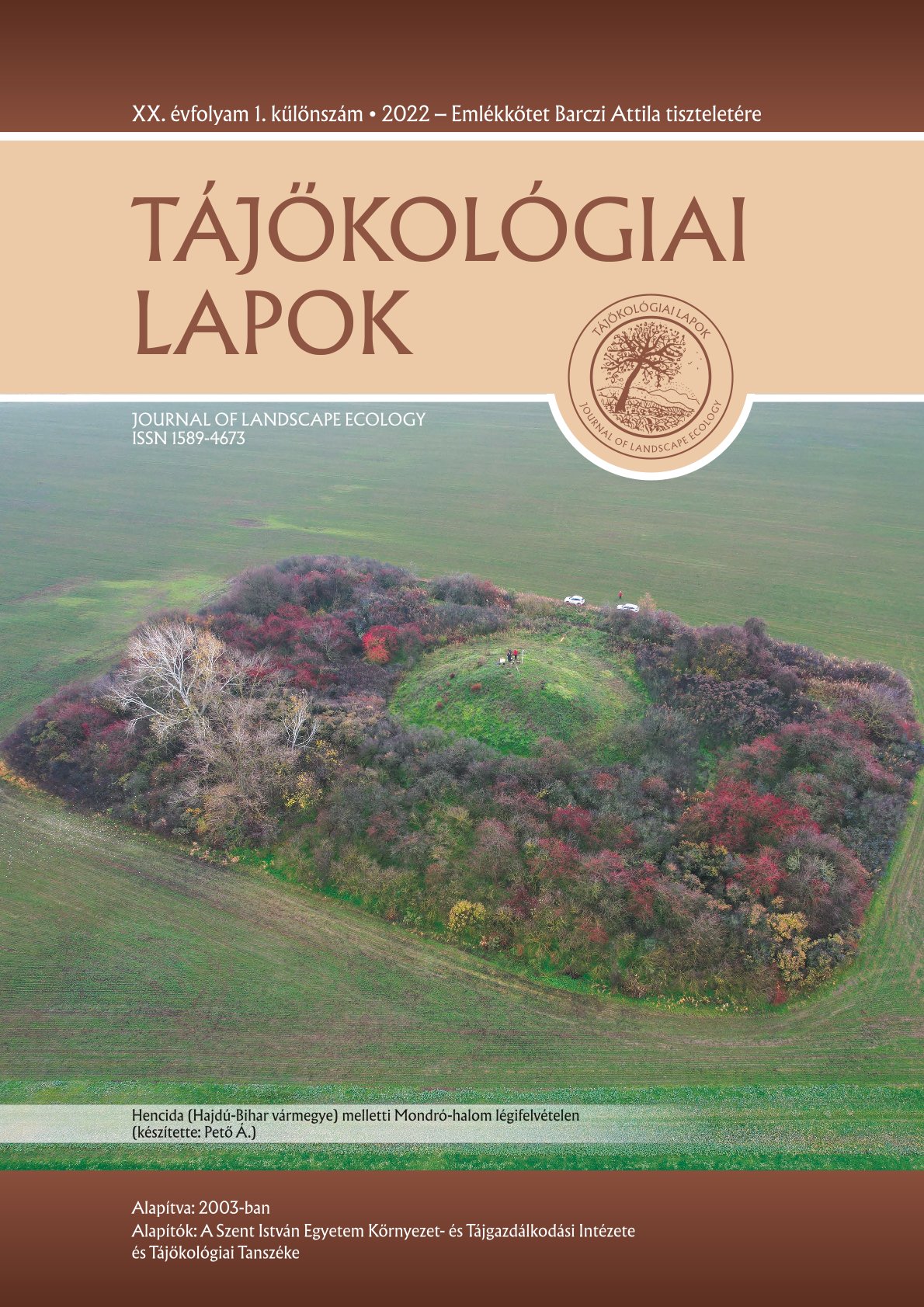Examination of Spatial Use of Natural Potentials and Territorial Cohesion
DOI:
https://doi.org/10.56617/tl.3146Keywords:
Attila Barczi, territorial cohesion, settlement development, measurement of regional development, natural capital, ecosystem services, complex indicatorAbstract
Attila Barczi was my teacher, then my colleague and my doctoral supervisor. During the years of research, we consulted countless times, matched our own fields of expertise, sought common ground, argued and developed our common denominator. My PhD research started from the basic premise that landscape and natural indicators do not participate in the system that determines and compares the development of regions and settlements. Most of our areas with a valuable natural environment are at a disadvantage in terms of their economic and social status. Our research focused on how these areas use the opportunities provided by the natural environment in their development? What developments are planned and how do they relate to the ecosystem services provided by their natural environment? Among the research results, we have been able to describe an applicable method for strengthening the role of the natural environment for the analysis of territorial cohesion, using data that are freely available to us.
References
Barczi, A., Csorba, P., Lóczy, D., Mezősi, G., Konkolyné Gyuró, É., Bardóczyné Székely, E., Csima, P., Kollányi, L., Gergely, E., Farkas, Sz., Ángyán, J., Podmaniczky, L., Pirkó, B., Joó, K., Centeri, Cs., Grónás, V., Vona, M., Pető, Á. 2008: Suggested landscape and agri-environmental condition assessment. Tájökológiai Lapok 6 (1-2): 77–94.
Buday-Sántha A. 2006: A környezeti elemek hatása a területi versenyképességre. In Horváth Gy. (szerk.): Régiók és települések versenyképessége MTA RKK, Pécs. pp. 352–384.
Camagni, R. 2008: Regional competitiveness: towards a concept of territorial capital. In: Capello (Eds): Modelling regional scenarios for the enlarged Europe. European competitiveness and global strategies. Springer, Berlin-Heidelberg. pp. 33–46.
Costanza, R. 2008: Ecosystem services: Multiple classification systems are needed. Letter to the Editor. Biological Conservation 141: 350–352.
Costanza R., d'Arge R., De Groot R., Farber S., Grasso M., Hannon, B.,Van den Belt M. 1997: The value of the world's ecosystem services and natural capital. Nature 387(6630): 253–260.
Costanza, R., De Groot, R., Sutton, P., Ploeg, S., Sharolyn, J. A., Kubiszewskia, I., Farber, S., Turner, R.K. 2014: Global Environmental Change 26: 152–158.
Csorba, P., Szabó, Sz. 2012: The application of landscape indices in landscape ecology. In: Tiefenbacher, J. (ed.): Perspectives on nature conservation - Patterns, pressures and prospects. InTech, Rijeka. pp. 121–140.
Daily, G. C. (Ed.) 1997: Nature's services. Societal dependence on natural ecosystems. Island Press, Wa-shington, DC. p. 392.
De Groot, R. 2003: Importance and threat as determining factors for criticality of natural capital. Ecological Economics 44 (2–3): 187–204. DOI: https://doi.org/10.1016/S0921-8009(02)00273-2
Kelemen, E, Pataki, Gy. (szerk.) 2014: Ökoszisztéma szolgáltatások: A természet- és társadalomtudomá-nyok metszéspontjában. Szent István Egyetem, Környezet- és Tájgazdálkodási Intézet, Gödöllő, Environmental Social Science Research Group, Budapest. pp. 24-28
Kovács, E., Kelemen, E., Czúcz, B. 2014: A természettől a jóllétig: az ökoszisztéma szolgáltatások termé-szet- és társadalomtudományi meghatározottsága. In: Kelemen E., Pataki Gy. (szerk.): Ökoszisztéma szolgáltatások: A természet- és társadalomtudományok metszéspontjában. Szent István Egyetem, Környezet- és Tájgazdálkodási Intézet, Environmental Social Science Research Group (ESSRG), Gö-döllő-Budapest. pp. 15–34
Kovács-Hostyánszki A., Arany I., Aszalós R., Bereczki K., Czúcz B., Fodor L., Kalóczkai Á., Kiss M., Ko-vács E., Takács András A., Vári Á., Zölei A., Zsembery Z. 2018: A közösségi jelentőségű természeti ér-tékek hosszú távú megőrzését és fejlesztését, valamint az EU biológiai sokféleség stratégia 2020 célki-tűzéseinek hazai megvalósítását megalapozó stratégiai vizsgálatok, Nemzeti ökoszisztéma-szolgáltatások térképezése és értékelése projektelem (NÖSZTÉP). Az ökoszisztéma-szolgáltatások priorizálása és a priorizálás eredményeinek szintézise, KEHOP-4.3.0-15-2016-00001, Budapest 2018. Január 10. Verzió: 1.2. pp. 1–35.
Malatinszky, Á. 2016: Stakeholder perceptions of climate extremes' effects on management of protected grasslands in a central European area. Weather, Climate and Society 8(3): 209–217. DOI: https://doi.org/10.1175/WCAS-D-15-0029.1
Millennium Ecosystem Assessment 2003: Ecosystems and Human Well-being, a framework for assessment. Island Press, Washington. pp. 64–70.
Oláh M. (szerk.) 2017: A területi tőke és magyarországi dimenziói. NYICITA Alapítvány, Balatonfűzfő. pp. 27–38.
Orosz Gy. 2020: Természeti potenciálok térségi használatának vizsgálata és a területi kohézió. Doktori értekezés. Gödöllő, p. 188. DOI: https://doi.org/10.14751/SZIE.2020.019
Stimson, R.J., Stough, R.R., Nijkamp, P. 2011: Endogenous regional developement. Edward Elgar Pub-lishing Limited, Cheltenham Glos. pp. 1–20.
Brink T. P. (ed.) 2011: TEEB –The Economics of Ecosystems and Biodiversity in National and Internatio-nal Policy Making. Earthscan, London and Washington. Welzel+Hardt, Wesseling, Germany. pp. 7–16.
Downloads
Published
Issue
Section
License
Copyright (c) 2022 Orosz György

This work is licensed under a Creative Commons Attribution-NonCommercial-NoDerivatives 4.0 International License.
A folyóirat Open Access (Gold). Cikkeire a Creative Commons 4.0 standard licenc alábbi típusa vonatkozik: CC-BY-NC-ND-4.0. Ennek értelmében a mű szabadon másolható, terjeszthető, bemutatható és előadható, azonban nem használható fel kereskedelmi célokra (NC), továbbá nem módosítható és nem készíthető belőle átdolgozás, származékos mű (ND). A licenc alapján a szerző vagy a jogosult által meghatározott módon fel kell tüntetni a szerző nevét és a szerzői mű címét (BY).












